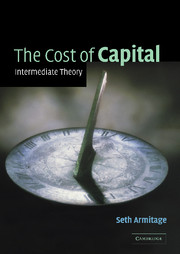Book contents
- Frontmatter
- Contents
- List of figures
- List of tables
- Preface
- Part I Expected Returns on Financial Assets
- 1 The cost of capital under certainty
- 2 Allowing for uncertainty: contingent states
- 3 The capital asset pricing model and multifactor models
- 4 The consumption-based model
- 5 The equity risk premium
- Part II A Project's Cost of Capital
- Part III Estimating the Cost of Capital
- References
- Index
1 - The cost of capital under certainty
Published online by Cambridge University Press: 05 June 2012
- Frontmatter
- Contents
- List of figures
- List of tables
- Preface
- Part I Expected Returns on Financial Assets
- 1 The cost of capital under certainty
- 2 Allowing for uncertainty: contingent states
- 3 The capital asset pricing model and multifactor models
- 4 The consumption-based model
- 5 The equity risk premium
- Part II A Project's Cost of Capital
- Part III Estimating the Cost of Capital
- References
- Index
Summary
The purpose of Part I is to examine how the expected returns on financial assets are determined in simple theoretical settings. We explain in Section 1.1 that a project can be thought of as a financial asset, and that its cost of capital is the expected return on the asset at market value. So we are really looking at how the cost of capital is determined. The settings are rather abstract, and may seem odd at first sight. The reason for the abstraction is to help in understanding the economic processes that determine a project's cost of capital in the real world.
The current chapter begins with a brief account of what the terms ‘capital’ and ‘cost of capital’ mean. It then considers the interest rate in a world in which the future is known with certainty. The assumption of certainty, though unrealistic, provides a relatively easy starting point. The analysis serves to establish several ideas that will be useful when uncertainty about the future is introduced in Chapter 2.
Concepts
Capital and investment
It is not as easy as one might expect to say what is meant by ‘capital’, and by the related terms ‘investment’, ‘saving’, ‘income’ and the ‘cost of capital’. In fact, there is a sizable literature in economics on these questions (e.g. Parker and Harcourt, 1969; Hirshleifer, 1970). We offer a brief discussion based on everyday usage.
- Type
- Chapter
- Information
- The Cost of CapitalIntermediate Theory, pp. 3 - 19Publisher: Cambridge University PressPrint publication year: 2005



